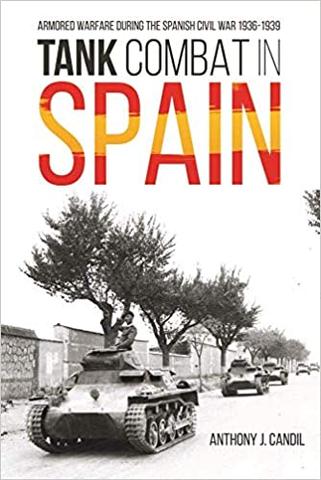Tank Combat in Spain

English language books on the use of armor during the Spanish Civil War of 1936-1939 are few and far between. Into this void now steps the well qualified Anthony J. Candil. He is a former senior officer in the Spanish Army with extensive training and experience in armored warfare. His expertise and background is evident in his approach to this topic, and is welcome.
Tank Combat in Spain is consice, well organized, and offers important insight into the employment of tanks during the war, lessons learned (or not learned) by the participating armed forces, as well as other armies observing those events at that time, and the impact these events had (or did not have) on the nations that would become the major combatants during the Second World War. The book begins with a good round-up of the Spanish Civil War's background, beginning, course, and conclusion. This grounds the reader in the larger environment in which armor was employed by the Nationalist and Republican forces, and their German/Italian and Soviet backers respectively.
From there the book moves into the arrival of Soviet, German, and Italian aid for their clients, balance of forces, and then operations. This is the meat of the book. These chapters are chock full of details regarding the employment by each side of armor during the entirety of the war, and the impact tanks had on the battlefields of Spain. The latter third of the book however are not to be overlooked. The final chapters provide extensive analysis of the strengths and weaknesses of the tanks employed, training, logistics, and the impact of anti-tank weapons on these rather light (by Second World War standards) tanks. I thoroughly enjoyed this discussion.
There are a number of important insights Tank Combat in Spain offers. Among the best are those surrounding the respective takeaway's of both outside observes (like the British or Americans) and the nation's supplying the tanks and combat support themselves (the Germans, Italians, and Russians). It is interesting to note the soundness of the German analysis regarding the usage of armor during the war and how to best learn from it. This stands in start contrast to the Soviet approach, where there is argumentation presented that credibly describes the role played by the usage of armor in Spain as being detrimental in terms of the lessons the Red Army took from this experience and the impact on how the Soviet Union chose to organize its armored units in the crucial 1938-1939 period. This being the time when the Red Army took an enormous step back from its co-world leading (with the Germans) position as the best in the world in armored operations. Finally, and perhaps most stunning, is the Italian response or lack thereof. In spite of the ineffectiveness of Italian armor (really tankettes at best) and the obviousness of the obsolescence of Italy's armored park, the Italians squandered the opportunity presented to take these years and upgrade their tank force in the year's leading up to their summer 1940 entry into the Second World War. An omission to learn, adapt, and act that would have terrible consequences for the entire Axis war effort in 1940-1942 in particular.
The pictures included with the book are superbly chosen in both their illustration of the larger points being made and assistance in bringing to life the book's topic. Maps are another story. There are none. As few as three-four maps could have done wonders for helping the reader visualize the events being described in the book. This omission is particularly glaring because the largely American readership of this book are hardly well acquainted with Spanish geography (and that holds true for even Second World War enthusiasts who typically overlook events in Spain during this time period). Perhaps a future edition will rectify this error.
Regardless, I otherwise recommend this book to my readers. First, it offers a great overview of the Spanish Civil War for those who are unfamiliar with this important prelude to the Second World War. From there, the analysis provided of the development, deployment, usage of, and respective strengths and weaknesses of the Panzer I, T-26, BT-5, and L3 CV-33/35 light tanks that formed the respective Nationalist and Republican armored parks is well worth your time.



Post new comment